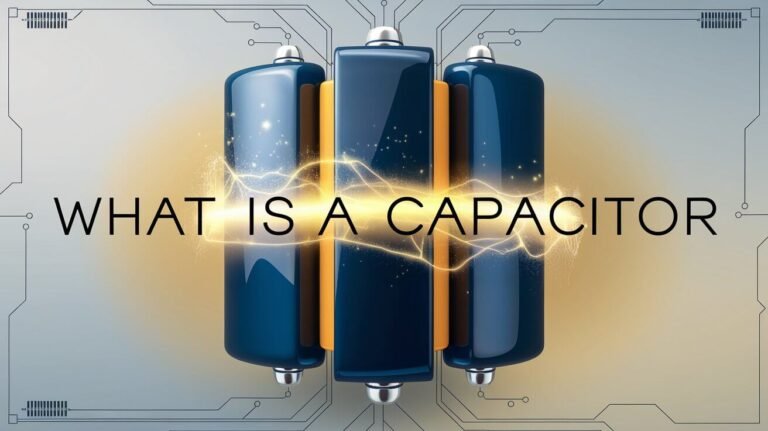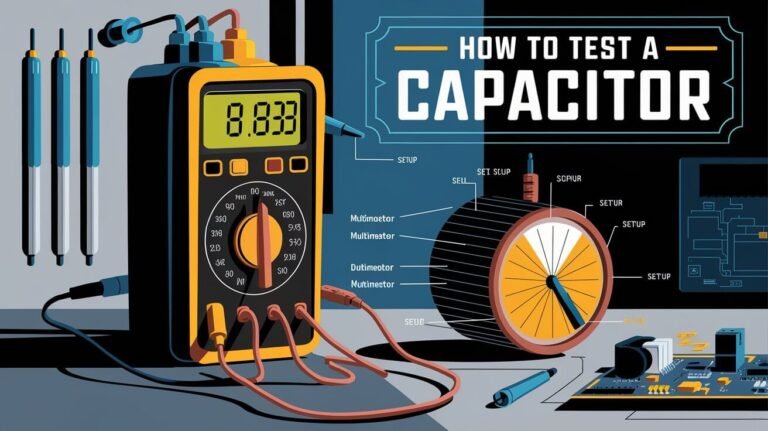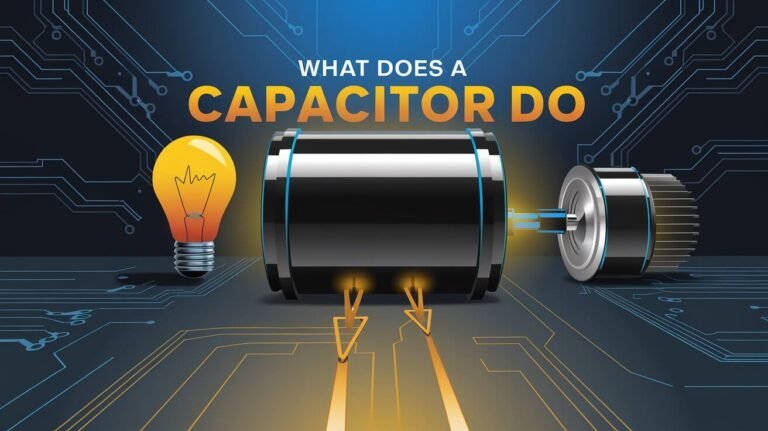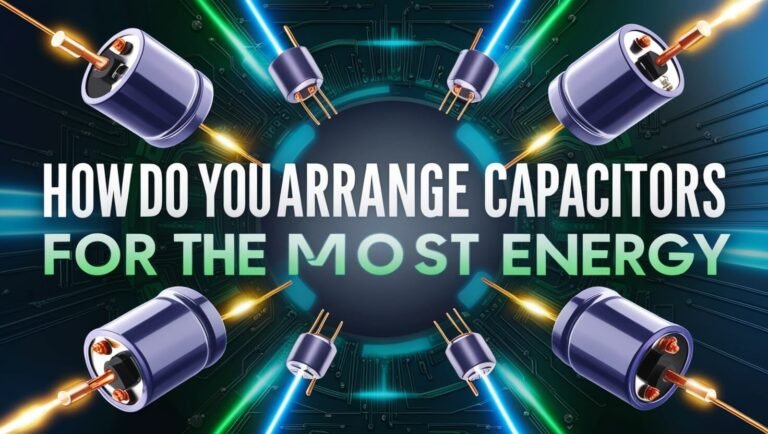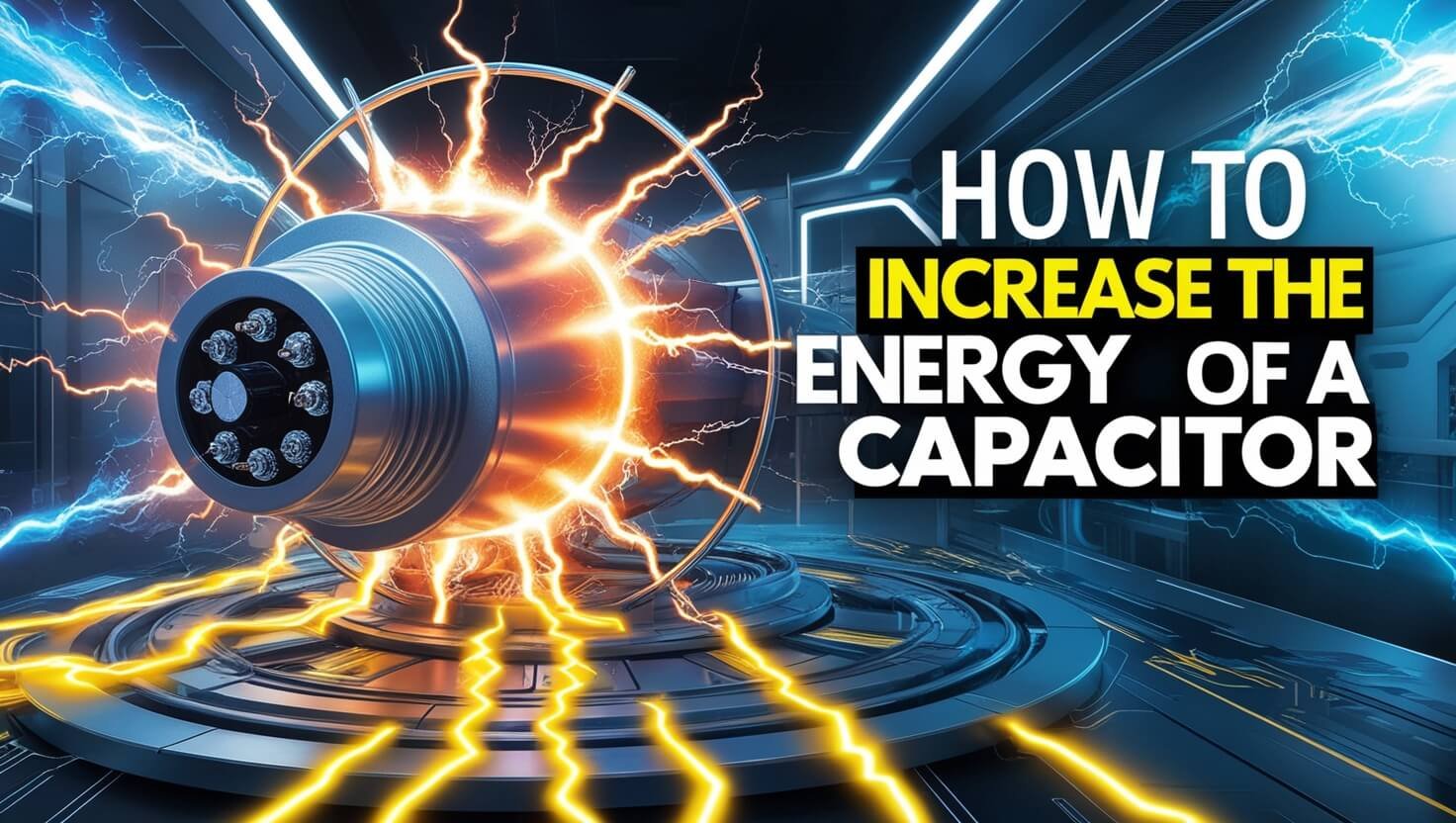
Capacitors are key in storing electrical energy. They are used in many areas, like heart defibrillators and microelectronics. The energy a capacitor holds is calculated by E = 1/2 CV^2, where C is capacitance and V is voltage.
This shows how important capacitor energy is in electrical systems. By improving capacitor energy, devices can give energy when batteries are full. They also power flash lamps on cameras, showing how vital capacitor energy is in our daily lives.
Increasing a capacitor’s energy is essential for better performance. The formula U_C = 1/2 V^2C shows that energy is directly tied to voltage and capacitance. This highlights the need to find ways to increase capacitor energy, making it a key part of electrical systems.
The Physics Behind Capacitor Energy Storage
Capacitor physics is key to understanding how energy is stored. The energy storage in capacitors relies on charge separation. This separation creates an electric field between the plates, storing energy.
The energy stored can be found using the formula E = 1/2 QV = 1/2 CV^2 = Q^2 / (2C). This formula shows how energy, charge, voltage, and capacitance are connected. It’s vital for grasping capacitor physics.
Energy Storage Mechanism in Capacitors
The energy storage in capacitors comes from charge separation. When a voltage is applied, the electric field between the plates separates charges. This separation stores energy. The energy stored depends on the charge-voltage relation, a core part of capacitor physics.
Fundamental Energy Equations
The key energy equations for capacitors link energy, charge, voltage, and capacitance. These equations help us understand how energy is stored and how to optimize it. By studying these equations, we learn about the charge-voltage relation and its impact on energy storage.
Charge-Voltage Relationships
The charge-voltage relationship is essential in capacitor physics. The energy stored in a capacitor is influenced by the charge-voltage relation. This relation is affected by capacitance and the applied voltage. Understanding this relationship helps improve capacitor performance and energy storage.
Voltage Rating and Energy Capacity
The voltage rating of a capacitor is key to its energy capacity. The energy stored in a capacitor goes up with the square of the voltage. So, a capacitor with a higher voltage rating can hold more energy. This is why it’s great for high-energy needs, like in automated external defibrillators.
When picking a capacitor, think about its voltage rating and energy capacity. A capacitor with a higher voltage rating can store more energy. But, it also risks damage if the voltage goes too high. The energy stored is found using the formula (C*V^2)/2, where C is capacitance and V is voltage.
| Voltage Rating (V) | Capacitance (μF) | Energy Capacity (μJ) |
|---|---|---|
| 4.0 | 4.0 | 32 |
| 8.0 | 4.0 | 130 |
| 10.0 | 8.0 | 400 |
In short, the voltage rating and energy capacity of a capacitor are linked. Knowing this helps designers and engineers pick the right capacitor. This ensures the best performance and reliability for their projects.
Capacitor Material Selection for Enhanced Energy Storage
The choice of dielectric materials is key for capacitor energy storage. These materials have special properties that impact energy density. The dielectric constant, for instance, is vital for capacitance, as seen in C = κε₀A/d.
There are many dielectric materials used in capacitors, each with its own benefits and drawbacks. Film, electrolytic, and ceramic capacitors are common. The energy storage in a capacitor depends on how the dielectric material polarizes when an electric field is applied. Knowing the properties of these materials helps us design better capacitors.
When picking dielectric materials, we look at their dielectric constant, breakdown strength, and energy density. Each material has unique properties, and the right choice depends on the application. For example, tantalum and ceramic capacitors are great for energy storage because of their high energy density.
| Dielectric Material | Dielectric Constant | Breakdown Strength | Energy Density |
|---|---|---|---|
| Ceramic | 10-100 | 10-100 kV/mm | 0.1-10 J/g |
| Tantalum | 10-100 | 10-100 kV/mm | 10-100 J/g |
| Film | 2-10 | 1-10 kV/mm | 0.01-1 J/g |
Choosing the right dielectric materials and understanding their properties, we can make capacitors that store more energy. This is important for many uses, from gadgets to renewable energy systems.
How Do You Increase The Energy Of A Capacitor Through Circuit Design
Circuit design is key to boosting a capacitor’s energy storage. By setting up capacitors in series or parallel, engineers can handle more voltage and store more energy. This is vital in devices needing lots of power, like power supplies and audio gear.
Improving energy efficiency is also a big deal in circuit design. Using capacitor networks helps cut down on energy loss and boosts circuit efficiency. Techniques like voltage balancing and network balancing are used. For instance, in series-parallel setups, capacitors are arranged to share voltage evenly. This lowers the chance of overvoltage and boosts energy storage.
Capacitor networks find use in many areas, including:
- Filtering out unwanted AC parts in DC power supplies
- Stopping unwanted oscillations in amplifier circuits
- Letting AC signals pass through while keeping DC stable in amplifiers
With smart circuit design and capacitor networks, engineers can enhance capacitor energy storage. This leads to more efficient and dependable circuits.
Parallel and Series Configurations
Capacitor setups come in two main types: parallel and series. These setups change how much energy a circuit can store. Parallel capacitors add up their capacitances, increasing energy storage. Series capacitors, on the other hand, reduce total capacitance, making less energy stored.
Series capacitors can handle higher voltages, which is good for some uses. But, they can also lead to uneven voltage sharing. Parallel capacitors, by contrast, offer better voltage balance and cost savings. Hybrid setups mix both, aiming for the best energy storage and voltage handling.
Energy Distribution in Parallel Circuits
In parallel circuits, energy is split among capacitors. Each stores part of the total energy. This setup boosts energy storage and improves voltage balance. The total capacitance is the sum of each capacitor’s, leading to more capacitance overall.
Series Connection Benefits
Series connections offer higher voltage ratings and better voltage balancing. The formula for total capacitance in series is: 1/Cs = 1/C1 + 1/C2 + 1/C3 + …, where Cs is the total and C1, C2, and C3 are individual capacitances.
Hybrid Configuration Options
Hybrid setups combine series and parallel elements. They aim for balanced energy storage and voltage management. These can be customized for various applications, improving performance and efficiency. Knowing the pros and cons of each helps designers create the best circuits for their needs.
| Configuration | Total Capacitance | Voltage Rating | Energy Storage |
|---|---|---|---|
| Parallel Capacitors | C1 + C2 + C3 + … | Increased | Increased |
| Series Capacitors | 1/Cs = 1/C1 + 1/C2 + 1/C3 + … | Increased | Decreased |
| Hybrid Configurations | Combination of series and parallel | Balanced | Optimized |
Temperature Management Techniques
Keeping capacitors at the right temperature is key to their performance and life. High temperatures can harm how they store energy and conduct electricity. That’s why good cooling systems are needed for today’s electronics.
There are ways to stop capacitors from overheating. These include using air, liquids, or fans to cool them down. The design of the capacitor and its surroundings play a big role in how well it can handle heat.
Important things to think about when managing heat include:
- Thermal conductivity of the capacitor’s medium
- Surface area of the capacitor
- Operating currents and environmental characteristics
- Cooling systems, such as natural air cooling or liquid cooling
Using the right cooling methods can make capacitors last longer and work better. This is very important in places where temperature affects how well they store energy. By focusing on cooling, we can make electronics more efficient and reliable.
Charging Methods and Energy Optimization
Charging capacitors in different ways can change how much energy they hold. Methods like constant current charging and pulse charging affect how well they store energy. Knowing these methods is key to getting the most out of capacitors.
How well a capacitor stores energy is very important. The right charging method, like constant current or pulse charging, can help it hold more energy. It’s also important to optimize energy storage to avoid damage and ensure the capacitor works well.
Constant Current Charging
This method charges the capacitor with a steady current. It’s pretty efficient, but the capacitor’s internal resistance can affect it. To get better efficiency, it’s important to keep the internal resistance low.
Pulse Charging Techniques
Pulse charging uses a series of pulses to charge the capacitor. This method can be gentler on the capacitor and more efficient. Adjusting the pulse width and frequency can help the capacitor store more energy.
Smart Charging Systems
Smart charging systems use advanced algorithms to fine-tune the charging process. They can adjust based on the capacitor’s charge level. This approach can help the capacitor store more energy and reduce the risk of damage.
The method used to charge a capacitor greatly affects its energy storage. Using the right methods, like constant current or pulse charging, and smart systems can maximize energy storage. This is vital in applications like power supplies and electric vehicles, where efficiency and reliability are key.
| Charging Method | Charging Efficiency | Energy Storage Capacity |
|---|---|---|
| Constant Current Charging | High | Medium |
| Pulse Charging Techniques | Medium | High |
| Smart Charging Systems | High | High |
Real-World Applications and Energy Enhancement
Capacitors are key in many areas, like consumer electronics and power systems. They help keep voltage and power flow steady. They store extra energy and give it out when needed most.
This makes sure we always have power and avoid blackouts. Capacitors also play a big role in other fields. They help in communication systems by filtering electrical signals.
They are also vital in medical imaging and in electric motors for things like air conditioners. This shows how important they are in many areas.
Capacitors are great because they can release energy fast and last a long time. They are also very efficient. This makes them a smart choice for many industries, like seaport cranes and hybrid vehicles.
Here are some examples of how capacitors are used:
- Electric vehicles, where they help store energy and improve power transfer
- Renameable energy systems, where they keep voltage and power steady
- Medical devices, for imaging and diagnostics
As technology gets better, we’ll need capacitors that can do more. They are essential in many fields, from gadgets to green energy systems. Their role will only grow as technology advances.
Conclusion
The search to increase the energy of a capacitor has led to big steps forward. We’ve seen new materials, better circuit designs, and smarter ways to charge. This work is making capacitors more powerful, with even more energy storage capabilities on the horizon.
New ideas in future developments are exciting. Things like high-performance materials, new capacitor designs, and smart charging systems are coming. These will make capacitors even more important for many technologies, like green energy, gadgets, and electric cars.
The energy storage advancements we talked about are real and happening now. Top companies and research groups worldwide are working on them. As these technologies get better, capacitors will become key in the future of energy and power.
FAQs
What is the fundamental principle behind capacitor energy storage?
Capacitors store energy by separating electric charge. This creates an electric field. This field holds the energy.
How do the fundamental equations link energy, charge, voltage, and capacitance?
The equations show how these variables are connected. They explain how changing them can increase stored energy.
Why is the voltage rating critical for a capacitor’s energy capacity?
Higher voltage ratings can increase energy storage. But, it’s important to consider safety and material strength.
How do different dielectric materials affect capacitor energy density?
The type of dielectric material used affects energy density. It impacts how well the capacitor performs.
What circuit design strategies can be used to maximize capacitor energy storage?
Using series or parallel configurations can help. So can balanced networks and voltage equalization.
How do parallel and series capacitor configurations affect energy distribution and storage?
Parallel circuits increase total capacitance and energy. Series connections boost voltage handling. Hybrid setups balance voltage and current.
How does temperature affect capacitor performance and energy storage capacity?
Temperature is key for capacitor operation. It affects dielectric properties and energy storage. Keeping temperature stable is important.
How do different charging methods impact the energy stored in a capacitor?
Charging methods like constant current or pulse charging affect efficiency. Smart systems can optimize charging for better energy storage.
What are some real-world applications where capacitor energy enhancement is critical?
Capacitor energy enhancement is vital in many fields. This includes high-energy physics, renewable energy, and electric vehicles.

